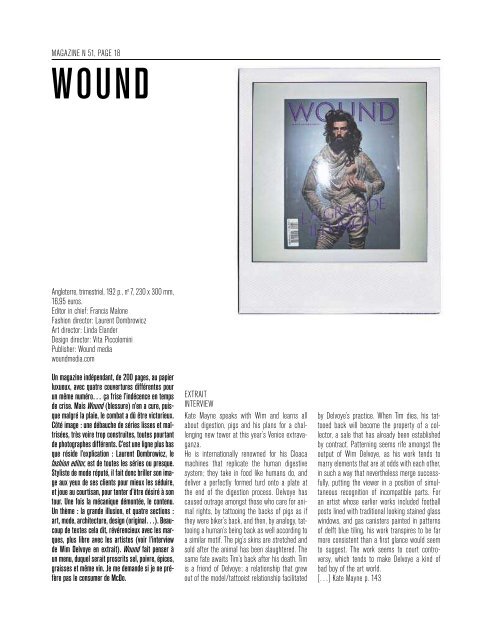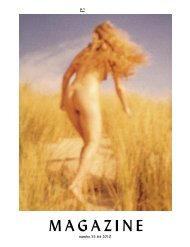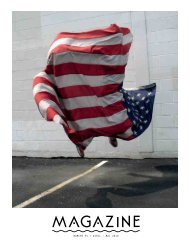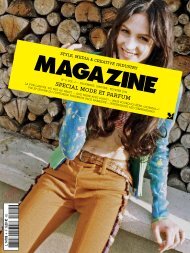You also want an ePaper? Increase the reach of your titles
YUMPU automatically turns print PDFs into web optimized ePapers that Google loves.
MAGAZINE N 51, PAGE 18<br />
WOUND<br />
Angleterre, trimestriel, 192 p., n o 7, 230 x 300 mm,<br />
16,95 euros.<br />
Editor in chief: Francis Malone<br />
Fashion director: Laurent Dombrowicz<br />
Art director: Linda Elander<br />
Design director: Vita Piccolomini<br />
Publisher: Wound media<br />
woundmedia.com<br />
Un magazine indépendant, de 200 pages, au papier<br />
luxueux, avec quatre couvertures différentes pour<br />
un même numéro… ça frise l’indécence en temps<br />
de crise. Mais Wound (blessure) n’en a cure, puisque<br />
malgré la plaie, le combat a dû être victorieux.<br />
Côté image : une débauche de séries lisses et maîtrisées,<br />
très voire trop construites, toutes pourtant<br />
de photographes différents. C’est une ligne plus bas<br />
que réside l’explication : Laurent Dombrowicz, le<br />
fashion editor, est de toutes les séries ou presque.<br />
Styliste de mode réputé, il fait donc briller son image<br />
aux yeux de ses clients pour mieux les séduire,<br />
et joue au courtisan, pour tenter d’être désiré à son<br />
tour. Une fois la mécanique démontée, le contenu.<br />
Un thème : la grande illusion, et quatre sections :<br />
art, mode, architecture, design (original…). Beaucoup<br />
de textes cela dit, révérencieux avec les marques,<br />
plus libre avec les artistes (voir l’interview<br />
de Wim Delvoye en extrait). Wound fait penser à<br />
un menu, duquel serait proscrits sel, poivre, épices,<br />
graisses et même vin. Je me demande si je ne préfère<br />
pas le consumer de McDo.<br />
Extrait<br />
INTERVIEW<br />
Kate Mayne speaks with Wim and learns all<br />
about digestion, pigs and his plans for a challenging<br />
new tower at this year’s Venice extravaganza.<br />
He is internationally renowned for his Cloaca<br />
machines that replicate the human digestive<br />
system; they take in food like humans do, and<br />
deliver a perfectly formed turd onto a plate at<br />
the end of the digestion process. Delvoye has<br />
caused outrage amongst those who care for animal<br />
rights, by tattooing the backs of pigs as if<br />
they were biker’s back, and then, by analogy, tattooing<br />
a human’s being back as well according to<br />
a similar motif. The pig’s skins are stretched and<br />
sold after the animal has been slaughtered. The<br />
same fate awaits Tim’s back after his death. Tim<br />
is a friend of Delvoye; a relationship that grew<br />
out of the model/tattooist relationship facilitated<br />
by Delvoye’s practice. When Tim dies, his tattooed<br />
back will become the property of a collector,<br />
a sale that has already been established<br />
by contract. Patterning seems rife amongst the<br />
output of Wim Delvoye, as his work tends to<br />
marry elements that are at odds with each other,<br />
in such a way that nevertheless merge successfully,<br />
putting the viewer in a position of simultaneous<br />
recognition of incompatible parts. For<br />
an artist whose earlier works included football<br />
posts lined with traditional looking stained glass<br />
windows, and gas canisters painted in patterns<br />
of delft blue tiling, his work transpires to be far<br />
more consistent than a first glance would seem<br />
to suggest. The work seems to court controversy,<br />
which tends to make Delvoye a kind of<br />
bad boy of the art world.<br />
[…] Kate Mayne p. 143











